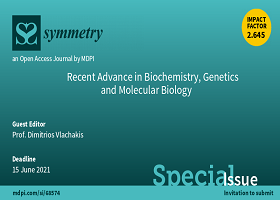Recent Advance in Biochemistry, Genetics and Molecular Biology
A special issue of Symmetry (ISSN 2073-8994). This special issue belongs to the section "Life Sciences".
Deadline for manuscript submissions: closed (30 September 2022) | Viewed by 6900

Special Issue Editor
Interests: functional role of long non-coding RNAs; stress mechanisms and homeostasis via nuclear receptors; computational and molecular virology under the prisms of genetics; computational biology; precision medicine
Special Issues, Collections and Topics in MDPI journals
Special Issue Information
Dear Colleagues,
Biochemistry, genetics, and molecular biology constitute an ever-changing field of modern biosciences. A lot of knowledge has been gained via basic research and strategies thereof have been designed with medical, biological, agricultural, and even environmental applications, starting from how basic biochemical reactions dictate the way in which cells operate, metabolize, and proliferate to advanced genetics or epigenetics of gene expression and regulation. New technology is continuously changing the scenery of modern biosciences and novel techniques allow the exploration of uncharted waters. For instance, who would have thought a few years ago that single-cell sequencing would be possible? The rate of knowledge acquisition, data collection, and innovation in the realm of biochemistry, genetics, and molecular biology has significantly increased, boosted, and fueled by the pandemic.
This Special Issue welcomes the submission of all articles stating or addressing recent advances in biochemistry, genetics, and molecular biology. This is a great opportunity to assemble and gather state-of-the-art research and review articles in a specialized depository that will serve as a world class reference to the abovementioned scientific field. Note that all submitted papers should be within the scope of the journal.
Prof. Dimitrios Vlachakis
Guest Editor
Manuscript Submission Information
Manuscripts should be submitted online at www.mdpi.com by registering and logging in to this website. Once you are registered, click here to go to the submission form. Manuscripts can be submitted until the deadline. All submissions that pass pre-check are peer-reviewed. Accepted papers will be published continuously in the journal (as soon as accepted) and will be listed together on the special issue website. Research articles, review articles as well as short communications are invited. For planned papers, a title and short abstract (about 100 words) can be sent to the Editorial Office for announcement on this website.
Submitted manuscripts should not have been published previously, nor be under consideration for publication elsewhere (except conference proceedings papers). All manuscripts are thoroughly refereed through a single-blind peer-review process. A guide for authors and other relevant information for submission of manuscripts is available on the Instructions for Authors page. Symmetry is an international peer-reviewed open access monthly journal published by MDPI.
Please visit the Instructions for Authors page before submitting a manuscript. The Article Processing Charge (APC) for publication in this open access journal is 2400 CHF (Swiss Francs). Submitted papers should be well formatted and use good English. Authors may use MDPI's English editing service prior to publication or during author revisions.





